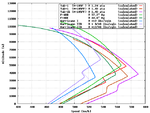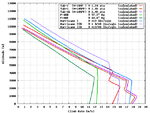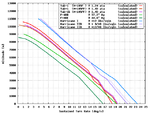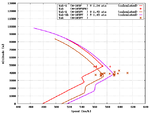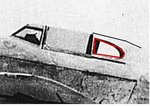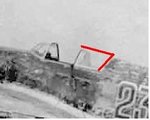Navigation
Install the app
How to install the app on iOS
Follow along with the video below to see how to install our site as a web app on your home screen.
Note: This feature may not be available in some browsers.
More options
You are using an out of date browser. It may not display this or other websites correctly.
You should upgrade or use an alternative browser.
You should upgrade or use an alternative browser.
P-40 vs. Yak-1 vs. Hurricane
- Thread starter Clay_Allison
- Start date
Ad: This forum contains affiliate links to products on Amazon and eBay. More information in Terms and rules
More options
Who Replied?Hi Vincenzo,
>why not +12 lbs for Hurricane II?
I believe the boost settings were increased incrementally for the Hurricane II, but I don't know the time line and thought the lower boost might be more representative for a 1942 comparison.
The final boost settings were +14 lbs/sqin in low gear and +16 lbs/sqin in high gear, which would of course yield better performance than what is indicated above.
However, I'm not sure it was available before 1942, and if we're talking about 1943 we might need to consider the Yak-9 instead of the Yak-1.
Regards,
Henning (HoHun)
>why not +12 lbs for Hurricane II?
I believe the boost settings were increased incrementally for the Hurricane II, but I don't know the time line and thought the lower boost might be more representative for a 1942 comparison.
The final boost settings were +14 lbs/sqin in low gear and +16 lbs/sqin in high gear, which would of course yield better performance than what is indicated above.
However, I'm not sure it was available before 1942, and if we're talking about 1943 we might need to consider the Yak-9 instead of the Yak-1.
Regards,
Henning (HoHun)
claidemore
Senior Airman
Henning,
They did change the exhaust stubs on the 'cleaned up' Yak1s, and I have seen later model Yak exhaust stubs termed as 'jet action exhaust stubs'.
Interesting sidebar, two prototype Yak1s were built with 3 x 20mm ShVAK cannon (one nose, two in the wings) and the two 7.62 ShKas mgs in the nose. Some Yak7UTI trainers also had two wing mounted cannons added for trials. Both were recomended for production, but the need for 'regular' Yak 1s and 7s took precedance.
They did change the exhaust stubs on the 'cleaned up' Yak1s, and I have seen later model Yak exhaust stubs termed as 'jet action exhaust stubs'.
Interesting sidebar, two prototype Yak1s were built with 3 x 20mm ShVAK cannon (one nose, two in the wings) and the two 7.62 ShKas mgs in the nose. Some Yak7UTI trainers also had two wing mounted cannons added for trials. Both were recomended for production, but the need for 'regular' Yak 1s and 7s took precedance.
Hi Vincenzo,
>why not +12 lbs for Hurricane II?
I believe the boost settings were increased incrementally for the Hurricane II, but I don't know the time line and thought the lower boost might be more representative for a 1942 comparison.
The final boost settings were +14 lbs/sqin in low gear and +16 lbs/sqin in high gear, which would of course yield better performance than what is indicated above.
However, I'm not sure it was available before 1942, and if we're talking about 1943 we might need to consider the Yak-9 instead of the Yak-1.
Regards,
Henning (HoHun)
thank for reply
Hi Vincenzo,
>why not +12 lbs for Hurricane II?
Thanks for the hint - WWII Aircraft Performance has a document showing that +12 lbs/sqin was cleared for the Hurricane II's engine pretty early on, though only for low gear.
I have added this in the graphs below.
(The effect of different boost levels on exhaust thrust is not perfectly simulated yet, but this is only an issue in the low gear, above-full-throttle-height bit of the graph and easily ignored
Regards,
Henning (HoHun)
>why not +12 lbs for Hurricane II?
Thanks for the hint - WWII Aircraft Performance has a document showing that +12 lbs/sqin was cleared for the Hurricane II's engine pretty early on, though only for low gear.
I have added this in the graphs below.
(The effect of different boost levels on exhaust thrust is not perfectly simulated yet, but this is only an issue in the low gear, above-full-throttle-height bit of the graph and easily ignored
Regards,
Henning (HoHun)
Attachments
Hi Claidemore,
>They did change the exhaust stubs on the 'cleaned up' Yak1s, and I have seen later model Yak exhaust stubs termed as 'jet action exhaust stubs'.
Thanks, I'll have to look into this.
Here is another graph showing the different speeds given by my internet source (actually a scan from a book someone posted and which I once saved) for a variety of Yak fighters (not just Yak-1's) in relation to my calculations.
Regards,
Henning (HoHun)
>They did change the exhaust stubs on the 'cleaned up' Yak1s, and I have seen later model Yak exhaust stubs termed as 'jet action exhaust stubs'.
Thanks, I'll have to look into this.
Here is another graph showing the different speeds given by my internet source (actually a scan from a book someone posted and which I once saved) for a variety of Yak fighters (not just Yak-1's) in relation to my calculations.
Regards,
Henning (HoHun)
Attachments
MikeGazdik
Senior Airman
Before I make my answer, I must confess a certain affection for the Russian equipment from WWII. My favorite WWII rifles to shoot and own are the Mosin Nagants. They are primal compared to the US/ British / German Mauser rifles, but man do I love them. I also really like thier aircraft.
But..... Having an airplane that will make a good campfire when I get shotdown is not my idea of an ideal fighter!
P-40 for me. I love the Hurricane too, but the Curtiss is my overall favorite. Nothing objective here, just totally biased desire.
But..... Having an airplane that will make a good campfire when I get shotdown is not my idea of an ideal fighter!
P-40 for me. I love the Hurricane too, but the Curtiss is my overall favorite. Nothing objective here, just totally biased desire.
claidemore
Senior Airman
excellent charts HoHun, thanks for sharing.
Hi Juha,
>the book is Yefim Gordon's and Dmitri Khazanov's Soviet Combat Aircraft of the Second World War Volume One: Single-Engined Fighters.
Thanks a lot! I've heard of this book before - seems it can be considered a quality source?
Regards,
Henning (HoHun)
>the book is Yefim Gordon's and Dmitri Khazanov's Soviet Combat Aircraft of the Second World War Volume One: Single-Engined Fighters.
Thanks a lot! I've heard of this book before - seems it can be considered a quality source?
Regards,
Henning (HoHun)
Hi Clay,
>So, say you need fighters and these three designs are on your desk. Which do you want?
Since I was about to go off-topic, I just spun off a new thread on Yakovlev fighters here:
http://www.ww2aircraft.net/forum/technical/performance-comparison-yakovlev-fighter-family-17580.htm
Thanks for getting me started on Yaks!
Regards,
Henning (HoHun)
>So, say you need fighters and these three designs are on your desk. Which do you want?
Since I was about to go off-topic, I just spun off a new thread on Yakovlev fighters here:
http://www.ww2aircraft.net/forum/technical/performance-comparison-yakovlev-fighter-family-17580.htm
Thanks for getting me started on Yaks!
Regards,
Henning (HoHun)
claidemore
Senior Airman
Hi Clay,
>So, say you need fighters and these three designs are on your desk. Which do you want?
Since I was about to go off-topic, I just spun off a new thread on Yakovlev fighters here:
http://www.ww2aircraft.net/forum/technical/performance-comparison-yakovlev-fighter-family-17580.htm
Thanks for getting me started on Yaks!
Regards,
Henning (HoHun)
Where is it? The link provided just takes me to the main Forums page.
EDIT: ahhh, found it. Here:
http://www.ww2aircraft.net/forum/technical/performance-comparison-yakovlev-fighter-family-17580.html
TenGunTerror
Airman
The Hurricane is hardly obsolete as it shot down 3/5 of all Luftwaffe aircraft, but my vote would be the Hurricane, average overall performance and a nasty armament.
claidemore
Senior Airman
The Hurricane is hardly obsolete as it shot down 3/5 of all Luftwaffe aircraft, but my vote would be the Hurricane, average overall performance and a nasty armament.
3/5 of all Luftwaffe aircraft during the BoB (summer of 1940). After that the Hurricane played mostly secondary roles, while the P40 replaced it in Africa and the Yak soldiered on in front line service, and in improved models, right up to the end of the war.
When you think about it, there are four fighter planes which were major factors in the war from start to finish. The 109, Spitfire, Zero, and Yak. Everything else either came in mid-war(P51 and FW190 for example), was considered sub-standard and replaced in their primary role(P40/F4F), required a major redesign (LaGG3>La5/MC200>MC202/205), or were soon obsolete (Ki27, I-16).
Basically, the Yak started out as the best Soviet fighter in 1941 (Yak 1), and finished as the arguably best (Yak 3, dogfighter) in 1945, and then went on in service into the 1950s. That puts it way ahead of a host of other fighter designs from 1940.
Last edited:
- Thread starter
- #37
Clay_Allison
Staff Sergeant
- 1,154
- Dec 24, 2008
I agree, except that the A6M was so badly outclassed at war's end I wonder if it is fair to say it was a major factor in 1945.3/5 of all Luftwaffe aircraft during the BoB (summer of 1940). After that the Hurricane played mostly secondary roles, while the P40 replaced it in Africa and the Yak soldiered on in front line service, and in improved models, right up to the end of the war.
When you think about it, there are four fighter planes which were major factors in the war from start to finish. The 109, Spitfire, Zero, and Yak. Everything else either came in mid-war(P51 and FW190 for example), was considered sub-standard and replaced in their primary role(P40/F4F), required a major redesign (LaGG3>La5/MC200>MC202/205), or were soon obsolete (Ki27, I-16).
Basically, the Yak started out as the best Soviet fighter in 1941 (Yak 1), and finished as the arguably best (Yak 3, dogfighter) in 1945, and then went on in service into the 1950s. That puts it way ahead of a host of other fighter designs from 1940.
Go with the Yak. Both the Hurricane and the P40 were either throwbacks or slapped together designs (P40 being based on the P36). They were at the end of their aeronautical tethers in terms of upgrading and improving. Yak was just starting out. While later marks of P40 and Hurricanes were better aircraft, they did not improve to the extent the Yak did. There wasn't the room.
Of the three, as flying machines, I've heard the Hurricane was relatively easy to fly. Same with the Yak. Heard the P40 was hairy to land due to the narrow landing gear. Not as bad as the 109, but tricky. Ground loops were common. Heard also the P40 had a nasty stall if certain situations but it is not a universal feeling by pilots that flew it.
Anyway, the Yak is my call.
Of the three, as flying machines, I've heard the Hurricane was relatively easy to fly. Same with the Yak. Heard the P40 was hairy to land due to the narrow landing gear. Not as bad as the 109, but tricky. Ground loops were common. Heard also the P40 had a nasty stall if certain situations but it is not a universal feeling by pilots that flew it.
Anyway, the Yak is my call.
From what I've read, including hunting down some Russian aviation sites the early Yak was considered a little premature in major service but necessary for immediate mass production due to the European climate. The Yak-1 was reportedly a little tricky to fly, the UTI two-seat trainer had a larger wing section and was more stable. When this was converted to fighter service (by simple removal of the rear controls, often very unpopularly replaced with an unprotected fuel tank), it became actually more popular among pilots than the single seat fighter version. The Yak-1 was a little more nimble however at their respective limits and remained popular with some more experienced pilots.
Yak quality was continually refined during production, particularly in terms of finish (some early examples could be improved by as much as 15km/h average with some refinishing by field maintenance personnel, quality control off the line was often poor for a time), and several modifications developed during 1942 (such as the clearance of higher boost rating for the M-105P motor, probably related to readily available fuel quality which was also very poor in 1941, recalibrated engines were designated M-105PF but were otherwise unaltered). Towards the end of 1942 the field modification of cutting down the rear fuselage had become popular for both Yak variants, replacing the hood with a bubble type canopy.
It was the Yak-7 which was converted to the Yak-9 improved model, both for its better stability and a more ubiquitous airframe, the floorplan of which could mount the cockpit either in the first station or the instructor station of the UTI floorplan. So different versions of the Yak-9 could have the cockpit forward, using an extra fuel tank or bomb bay for the rear area; or alternatively have the cockpit rearward and mount heavy weapons such as a Nudelman cannon to fire through the propeller hub, with the breech and magazine in the forward section. In a basic fighter layout you could play with the centre of gravity a little by choosing where to mount the cockpit. And it was all on the same production lines using the same tooling.
Later the Yak-1 was essentially fitted with wing sections from the Yak-7 to produce the Yak-3, which of course included all other general improvements of the period. But these were equipped only to Guards units. During 1945 both the Yak-3 and Yak-9 were now earmarked for all metal skinning and the latest Klimov 1650hp engine, but production realities and demands meant the Yak-9 received this engine whilst the Yak-3 made do with a further refined M-105, with tolerances adjusted once again to reflect the current fuel quality and machine production quality control standards (VK-105PF2, ca1450hp). Nevertheless at low altitude the Yak-3 gained a reputation as perhaps the most deadly turn fighter of the war, whilst the Yak-9U compared well with any contemporary at all heights. Both continued into production postwar, but the main service fighter remained the Yak-9 in P form, fitted with 3x B20 guns iirc and served in Korea. A captured Yak-9P was comparatively tested at Wright-Patterson and judged to be equivalent to the P-51D in all respects except more manoeuvrable.
All in all my impressions are that the Yak started out as a Hurricane equivalent, and wound up a Spitfire (Yak-9 and 3) or a Mustang (Yak-9U/P).
Yak quality was continually refined during production, particularly in terms of finish (some early examples could be improved by as much as 15km/h average with some refinishing by field maintenance personnel, quality control off the line was often poor for a time), and several modifications developed during 1942 (such as the clearance of higher boost rating for the M-105P motor, probably related to readily available fuel quality which was also very poor in 1941, recalibrated engines were designated M-105PF but were otherwise unaltered). Towards the end of 1942 the field modification of cutting down the rear fuselage had become popular for both Yak variants, replacing the hood with a bubble type canopy.
It was the Yak-7 which was converted to the Yak-9 improved model, both for its better stability and a more ubiquitous airframe, the floorplan of which could mount the cockpit either in the first station or the instructor station of the UTI floorplan. So different versions of the Yak-9 could have the cockpit forward, using an extra fuel tank or bomb bay for the rear area; or alternatively have the cockpit rearward and mount heavy weapons such as a Nudelman cannon to fire through the propeller hub, with the breech and magazine in the forward section. In a basic fighter layout you could play with the centre of gravity a little by choosing where to mount the cockpit. And it was all on the same production lines using the same tooling.
Later the Yak-1 was essentially fitted with wing sections from the Yak-7 to produce the Yak-3, which of course included all other general improvements of the period. But these were equipped only to Guards units. During 1945 both the Yak-3 and Yak-9 were now earmarked for all metal skinning and the latest Klimov 1650hp engine, but production realities and demands meant the Yak-9 received this engine whilst the Yak-3 made do with a further refined M-105, with tolerances adjusted once again to reflect the current fuel quality and machine production quality control standards (VK-105PF2, ca1450hp). Nevertheless at low altitude the Yak-3 gained a reputation as perhaps the most deadly turn fighter of the war, whilst the Yak-9U compared well with any contemporary at all heights. Both continued into production postwar, but the main service fighter remained the Yak-9 in P form, fitted with 3x B20 guns iirc and served in Korea. A captured Yak-9P was comparatively tested at Wright-Patterson and judged to be equivalent to the P-51D in all respects except more manoeuvrable.
All in all my impressions are that the Yak started out as a Hurricane equivalent, and wound up a Spitfire (Yak-9 and 3) or a Mustang (Yak-9U/P).
claidemore
Senior Airman
Just a few corrections to vanirs excellently worded post:
The Yak 1, Yak 7 and Yak 9 all had exactly the same size wing, 17.15 sq meters. The Yak 3, had a smaller wing, 14.85 sq meters. There may have been some differences in how the Yak7/9 wing was constructed.
The Yak 9T had the cockpit moved back a few inches to make room for the 37mm cannon, but it was not put in the 'backseat' positon of the UTI trainer. Afaik, the cockpit in the Yak7 or Yak 9 was not moveable from front to rear position and was only produced in the forward position. The fighter Yak 7 did not have dual controls afaik.
I have a theory that the story about field modifications 'cutting down the rear fuselage', is a misunderstanding. To do that in the field would require major structural modification, not to mention fabricating a curved perspex canopy. I beieve that the 'cutting down' was actualy cutting out, that the field modification was to cut out the top section of the fuselage directly behind the pilot, giving a better view up and to the rear, but not changing the actual shape of the rest of the fuselage, or installing a 'bubble' canopy. Consider the following two enlarged photos of a 1941 (Winter variant) Yak 1, and a 1942 Yak 1. The red lines show the difference in the rear canopy area. I suspect this modification was made as a result of the better rear view in the Yak 7 which had lots of glass in the back, but the same fuselage profile.
The Yak 1, Yak 7 and Yak 9 all had exactly the same size wing, 17.15 sq meters. The Yak 3, had a smaller wing, 14.85 sq meters. There may have been some differences in how the Yak7/9 wing was constructed.
The Yak 9T had the cockpit moved back a few inches to make room for the 37mm cannon, but it was not put in the 'backseat' positon of the UTI trainer. Afaik, the cockpit in the Yak7 or Yak 9 was not moveable from front to rear position and was only produced in the forward position. The fighter Yak 7 did not have dual controls afaik.
I have a theory that the story about field modifications 'cutting down the rear fuselage', is a misunderstanding. To do that in the field would require major structural modification, not to mention fabricating a curved perspex canopy. I beieve that the 'cutting down' was actualy cutting out, that the field modification was to cut out the top section of the fuselage directly behind the pilot, giving a better view up and to the rear, but not changing the actual shape of the rest of the fuselage, or installing a 'bubble' canopy. Consider the following two enlarged photos of a 1941 (Winter variant) Yak 1, and a 1942 Yak 1. The red lines show the difference in the rear canopy area. I suspect this modification was made as a result of the better rear view in the Yak 7 which had lots of glass in the back, but the same fuselage profile.
Attachments
Last edited:
Users who are viewing this thread
Total: 1 (members: 0, guests: 1)

